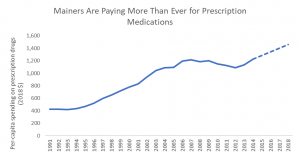No one’s health should be compromised because they can’t afford the medicine they need. The runaway increases in the costs of prescription drugs must be stopped, and LD 1162, “An Act to Further Improve Prescription Drug Transparency,” is an important step to doing that.
Health care costs are squeezing Mainers’ budgets tighter and tighter every year. Since 1997, health care has increased as a share of consumer spending from 15 percent in 1997 to 18 percent in 2017.[1] Spending on prescription medications, especially where the prices are artificially high, reduces the ability of Mainers to do everything from putting food on the table to saving for the future.
The cost of prescription drugs has been rising faster than almost any other health care expense in recent years.[2] Per capita spending on prescription drugs has risen roughly three times as fast as regular increases in the cost of living,[3] with the price of common brand-name drugs skyrocketing even faster. A U.S. Senate report found that the 20 most commonly-prescribed brand-name drugs purchased through Medicare Part D had average price increases 10 times the rate of inflation between 2012 and 2017.[4]

If you’re a worker whose wages are barely increasing or a senior on a fixed income, what are you supposed to do when your life-saving medicine is harder to afford every year?
While the Affordable Care Act has helped more Americans obtain health insurance and reduced the out-of-pocket costs for many who are insured, many still struggle to afford prescription medications. For some Mainers, paying for prescriptions means going without necessities such as food, rent, or utilities. For others, it means finding ways to stretch out their supply of medicine. Among non-elderly adults, 11 percent either skipped doses or took smaller doses of their medicine because they couldn’t afford the correct course of treatment.[5] Another 7 percent needed a prescription but didn’t get one at all because they couldn’t afford it.[6] The price of prescription drugs has become a near-insurmountable barrier to good health for millions of Americans and tens of thousands of Mainers.
Last session, the legislature authorized the first drug price transparency report in Maine. The results are revealing.[7]
- The report provides the first comprehensive estimate for spending on prescription drugs in Maine since the federal government stopped collecting data in 2014.[8] In 2014, the federal government estimated Mainers spent $1.5 billion on prescription drugs. In 2018, the Maine Health Data Organization estimated that had increased to almost $1.9 billion. After accounting for the cost of living and population changes, that’s the equivalent of a 19 percent increase in just four years.[9]
- Some of the largest price increases are for medications to treat chronic conditions such as diabetes and asthma. The price of Trulicity, an insulin drug, increased from $900 per prescription in FY 2107 to $1,056 per prescription in FY 2018. The cost of Humalog, another common form of insulin, increased from $776 to $899 per prescription.
- These increases are costing the state millions of dollars every year. One of the most commonly-prescribed drugs for MaineCare patients is Proventil, used to treat asthma. Between FY 2016/7 and FY 2017/8 the price of Proventil increased by 11 percent, which resulted in an additional cost of $554,000 for the year.[10]
LD 1162 would build on last year’s work. It would provide lawmakers, consumers, providers, and insurers with price information about a greater number of drugs than the previous law, and it would ask pharmaceutical companies to justify those prices by breaking down the costs of research, manufacture, and sale of prescription drugs. Mainers have a right to know whether the price they’re paying for prescriptions is the result of research and development costs, or inflated marketing budgets and executive salaries.
More transparency is essential for patients to be informed, and for lawmakers to take appropriate action to reduce the barrier of price that’s standing between Mainers and good health.
Notes
[1] US Bureau of Economic Analysis, Personal Consumer Expenditures.
[2] Center for Medicare and Medicaid Services, National Health Expenditure Survey (national data). Per-capita costs for prescription drugs increased an average of 4.8% annually between 2012 and 2017, behind only the administrative costs of health insurance (6.6%) and care in residential and other non-home, non-provider settings (5.4%).
[3] The Consumer Price Index for 2012-2017 increased by 1.35% annually on average between 2012 and 2017.
[4] US Senate Homeland Security and Government Affairs Committee, Minority Office, “Manufactured Crisis: How Devastating Drug Price Increases Are Harming America’s Seniors,” nd. Web. Available at https://www.hsgac.senate.gov/imo/media/doc/Manufactured%20Crisis%20-%20How%20Devastating%20Drug%20Price%20Increases%20Are%20Harming%20America’s%20Seniors%20-%20Report.pdf
[5] US Centers for Disease Control, National Center for Health Statistics, Data Brief 333, “Strategies Used by Adults Aged 18-64 to Reduce Their Prescription Drug Costs, 2017,” March 2019. Web. Available at https://www.cdc.gov/nchs/products/databriefs/db333.htm
[6] National Health Interview Survey 2017 data via IPUMS.
[7] Report available online at https://mhdo.maine.gov/tableau/prescriptionReports.cshtml
[8] Center for Medicare and Medicaid Services, National Health Expenditure Survey.
[9] MECEP estimate using the Consumer Price Index and US Census Bureau population estimates. In 2018 dollars, per-capita spending on prescription drugs by Maine residents was $1,226 in 2014 and $1,461 in 2018.
[10] MECEP analysis based on US Centers for Medicare and Medicaid Services, State Drug Utilization Data, 2016-2018.



